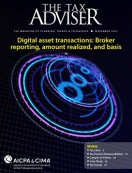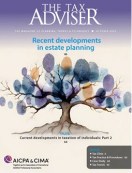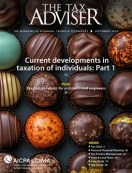- tax clinic
- procedure & administration
Amended returns and the Sec. 965(k) six-year period for assessment
Related
IRS clarifies health savings account changes in H.R. 1 in new notice
PTEs need more notice of changes, more time to respond, AICPA says
IRS announces prop. regs. on international tax law provisions in OBBBA
Editor: Christine M. Turgeon, CPA
The Tax Cuts and Jobs Act, P.L. 115–97, amended Sec. 965 to require U.S. shareholders (as defined in Sec. 951(b)) to pay a transition tax (often referred to as a “toll charge”) on the untaxed foreign earnings of certain specified deferred foreign income corporations as if those earnings had been repatriated to the United States. The Sec. 965 inclusion year is the last tax year of the deferred foreign income corporation that began before Jan. 1, 2018, such that the toll charge inclusion year for calendar–year taxpayers was the tax year ended Dec. 31, 2017. A U.S. shareholder of a deferred foreign income corporation may have paid its toll charge “net tax liability” as a single installment or, alternatively, may have elected to pay the net tax liability in installments over eight tax years pursuant to Sec. 965(h). Final installments under Sec. 965(h) for 2017 inclusion years were generally due April 15, 2025, bringing final resolution to what has been for many taxpayers a lengthy period of toll charge liability determination, assessment, and installment payments.
Questions have arisen whether language in the Joint Committee on Taxation (JCT) General Explanation of Public Law 115–97, Rep’t No. JCS–1–18 (December 2018) (the “Blue Book”), casts doubt on the finality of this resolution where the U.S. shareholder filed an amended return for the 2017 inclusion year either (1) to report for the first time a Sec. 965 toll charge liability or (2) to increase a previously reported toll charge liability.
Periods of limitation on assessment
Under Sec. 6501(a), the IRS generally has three years after the return is filed to assess tax, but there are several exceptions. For example, the assessment period may be extended by mutual agreement under Sec. 6501(c)(4) through signing Form 872, Consent to Extend the Time to Assess Tax.
A Sec. 965 liability is subject to an extended period of limitation on assessment under Sec. 965(k), which provides that “the limitation on the time period for the assessment of the [Sec. 965 liability] shall not expire before the date that is 6 years after the return for the taxable year … was filed.” In other words, Sec. 965(k) provides a minimum time for the IRS to assess a Sec. 965 liability. The time may be longer than the six–year period — for example, if the assessment statute has been extended by the signing of Form 872 — but will not be shorter. As stated by the JCT in the Blue Book explanation for P.L. 115–97:
The provision establishes a minimum period of six years for assessment of the transition tax, or underpayments with respect to the transition tax, measured from the date on which the return initially reflecting the section 951 inclusion was filed. … The provision does not operate to shorten any otherwise applicable limitations period that would provide a greater period for such adjustments or assessments. [emphasis added]
The reference to Sec. 951 reflects that Sec. 965 requires a Subpart F inclusion pursuant to Sec. 951.
Questions raised by the JCT Blue Book language: What is ‘the return’?
Both Sec. 6501(a), providing the general three–year assessment period, and Sec. 965(k), providing the minimum six–year period, refer to “the return.”
Generally, “the return” for assessment statute purposes is the original return, not any superseding or amended return (see, e.g., Zellerbach Paper Co. v. Helvering, 293 U.S. 172 (1934)). The “significance of the original, and not the amended, return has been stressed” by the Supreme Court in the context of Sec. 6501 (Badaracco, 464 U.S. 386, n.8 (1984)). The IRS Office of Chief Counsel (Procedure & Administration) more recently confirmed its position that the original return, not any superseding return, starts the assessment statute, as in Chief Counsel Advice memorandum (CCA) 202026002 (Feb. 26, 2020), which states in part, “Under Zellerbach and National Paper, the original return, not the superseding return, starts the period of limitations for assessment under section 6501.” Quoting the Supreme Court in Badaracco, the CCA further states that it “has been consistently held that the filing of an amended return in a nonfraudulent situation does not serve to extend the period within which the Commissioner may assess a deficiency.”
The potential wrinkle in the Sec. 965 context is that the JCT Blue Book explanation for the six–year period under Sec. 965(k) adds the modifier “initially reflecting the section 951 inclusion” to describe — or perhaps define — “the return” from which the six–year period is measured.
What if a taxpayer’s original 2017 return does not reflect any Sec. 965 toll charge and concomitant Sec. 951 inclusion, but an amended 2017 return filed Oct. 15, 2021, does? Does the six–year period run from the amended return, which “initially reflect[s] the section 951 inclusion”? Or if the original return reported a small toll charge but the amended return reports an additional amount, does the six–year period run from the amended return with respect to the additional Sec. 951 inclusion reported on the amended return?
Measuring the assessment period
Two items are worth noting here. First, the seminal cases referenced above, including Zellerbach, and the informal CCA guidance from the IRS Office of Chief Counsel (Procedure & Administration) addressed Sec. 6501 or its predecessor. Sec. 965(k) addresses the period of limitation on assessment, similar to Sec. 6501, but is a different Code provision entirely. Accordingly, guidance applying Sec. 6501 or its predecessor is not necessarily binding, nor is it entirely surprising that a slightly different outcome might result under a different Code provision.
Although not perfectly analogous, assessments relating to years that otherwise would be closed under Sec. 6501 may be permitted under Secs. 481(a) and 905(c). For example, see Secs. 6501(c)(5) and 905(c)(3); also Graff Chevrolet Co. v. Campbell, 343 F.2d 568 (5th Cir. 1965), addressing the “apparent conflict between the adjustment provisions of section 481 … and the statute of limitations [under] section 6501(a)” and concluding that Sec. 481 authorizes the IRS “to tax amounts that should have been reported in closed years.”
The second item to note is that Sec. 6501(c)(7) provides a special rule for certain amended returns, such that if an amended return reporting additional tax liability is filed within the last 60 days for the IRS to make an assessment under Sec. 6501, the Service has at least 60 days to assess the additional tax reported. For example, if the three–year period under Sec. 6501(a) is set to expire Oct. 15, 2021, then for an amended return filed Oct. 14, 2021, and reporting additional tax, the IRS will have at least 60 days from Oct. 14, 2021, to assess the additional tax. By its terms, however, Sec. 6501(c)(7) applies if the amended return is filed within the last 60 days of a period prescribed “in this section” — that is, in Sec. 6501.
If the six–year period under Sec. 965(k) runs from the original return for the tax year, an amended return filed on the last date of the six–year period and reporting a Sec. 965 toll charge for the first time (or an additional amount of toll charge) may leave the IRS without the 60 days to assess that additional tax provided for by Sec. 6501(c)(7), because the amended return was not filed within the last 60 days of a period under Sec. 6501. For example, if an original 2017 return is filed on Oct. 15, 2018, the six–year period would expire Oct. 15, 2024. An amended return for 2017 filed Oct. 14, 2024, and reporting a Sec. 965 toll charge for the first time would be filed within the six–year period of Sec. 965(k); however, it would not be filed within the last 60 days of any period under Sec. 6501, and as a result, the 60–day period in Sec. 6501(c)(7) may not apply to permit the IRS a 60–day window from Oct. 14, 2024, to make an additional assessment.
A view that the six–year period under Sec. 965(k) is measured from the original return might, therefore, leave the IRS without time as a practical matter to assess a toll charge liability reported on an amended return. Sec. 6501(c)(7) is intended to prevent such a situation but does not apply by its terms if the assessment statute is not otherwise open under Sec. 6501. Alternatively, a view that the six–year period under Sec. 965(k) is measured — or restarts — from an amended return reporting a toll charge liability for the first time (or reporting additional toll charge liability) would address this concern by providing the IRS six years from the amended filing to assess the additional tax.
Thus, the Blue Book language raises an interesting question, and consideration of Sec. 6501(c)(7) and the parallel situation under Sec. 965(k) identifies potentially disparate treatment for amended returns filed under a “normal” Sec. 6501 assessment period versus the six–year period under Sec. 965(k).
The statute and the Internal Revenue Manual
Despite the Blue Book language, the language of Sec. 965 itself might not be read as providing that the six–year period of Sec. 965(k) is measured from an amended return “initially reflecting” a toll charge liability amount.
That is, Sec. 965(k) identifies “the return” as “the return for the taxable year described in” Sec. 965(h)(6), which is “the taxable year in which an amount is included in the gross income of such United States shareholder under section 951(a)(1) by reason of” Sec. 965. For purposes of determining the relevant tax year — the inclusion year — an amended return or superseding return may be relevant by virtue of reporting a toll charge liability. For example, if an original return for 2017 does not report any toll charge amount, but an amended return for 2017 subsequently filed does, 2017 becomes a Sec. 965 toll charge year by virtue of the amended filing. The statutory language, however, does not define which filing is “the return” as between an original, superseding, or amended return. Absent clear legislative intent otherwise, it may not be appropriate to read Sec. 965(k) in a manner contrary to long–standing case law applicable to determining the relevant filing for purposes of measuring a period of limitation under Sec. 6501. See, for example, Guerrero–Lasprilla v. Barr, 589 U.S. 221, 232 (2020), which states, “We normally assume that Congress is ‘aware of relevant judicial precedent’ when it enacts a new statute” (internal citation omitted). In other words, Sec. 965(k) might not be read to state that the period during which the IRS may make an assessment begins to run from a filing other than the original return, when it does not so state.
Although case law or other authoritative guidance does not address the question raised by the JCT Blue Book language, the IRS has taken a position in the Internal Revenue Manual (IRM). For example, IRM Section 25.6.1.9.5.9 (March 17, 2022), IRC 965 Statute Considerations, states in part in paragraph (1) that “IRC 965(k) … provides that the statute of limitations for assessment with respect to an IRC 965 net tax liability will not expire before six years after the date the original return for the inclusion year is filed.” Further, IRM Section 21.5.13.2.6 (Oct. 1, 2022), Statute Imminent Adjustments, advises examiners that the Sec. 965(k) six–year statute begins to run from the original return, stating in paragraph (1):
IRC 965(k) allows for a 6–year statute of limitations (SOL) on assessments for IRC 965 net tax liabilities. This provision allows 6 years from when the original return was filed, including extensions (3 years past the assessment statute expiration date (ASED)) to assess IRC 965 net tax liabilities.
Despite the Blue Book language described above, it appears the IRS has determined that the statutory text of Sec. 965, viewed in light of the judicial precedent in place when P.L. 115–97 was enacted, precludes measuring the Sec. 965(k) six–year period from an amended or superseding return.
Editor
Christine M. Turgeon, CPA, is a partner with PwC US Tax LLP, Washington National Tax Services, in New York City.
For additional information about these items, contact Turgeon at christine.turgeon@pwc.com.
Contributors are members of or associated with PwC US Tax LLP.














